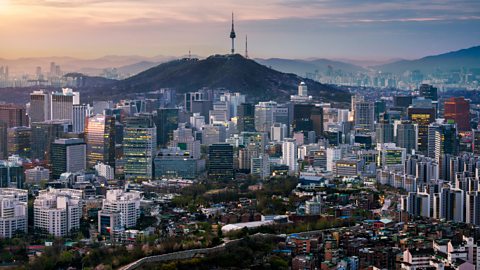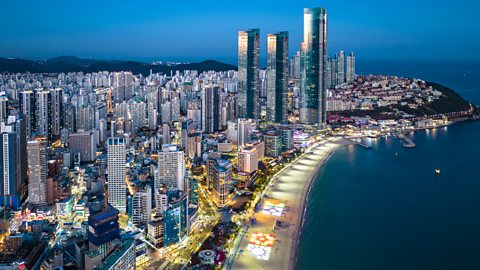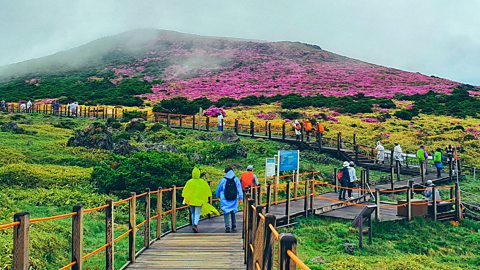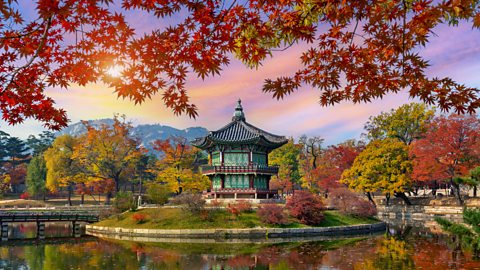Why South Korea should be your next ‘workcation’
6 min readBy Lindsey GallowayFeatures correspondent

 Mongkol Chuewong/Getty Images
Mongkol Chuewong/Getty ImagesLaunched on 1 January 2024, South Korea’s newest visa allows digital nomads to stay for up to two years while maintaining a job back home.
South Korea hasn’t typically ranked as a top country for digital nomads, but the country’s newest visa is looking to change that. Announced in late 2023 and effective 1 January 2024, this new “workcation” visa now allows workers (and their families) to stay in the country for up to two years. Previously, foreigners could only qualify for a tourist visa or stay for fewer than 90 days.
To qualify, applicants must be employed by a foreign company and have worked in the same industry for at least one year. They must also have an annual salary of 84.96 million won (about £50,000) and personal health insurance of at least 100 million won (about £59,000). The visa is not only meant to encourage economic development, but also showcase South Korean landmarks to boost the tourism industry.
Travellers who have previously spent stints in the country say the location has been underrated in remote worker circles. “South Korea, with its blend of modernity and tradition, emerged as a cultural haven for our digital nomad journey,” said Hammer Tsui, who recently spent a few months in the country and blogs at A Fun Couple. “The experience was not just about remote work; it was about immersing ourselves in a tapestry of history, technology and hospitality. “
To uncover how best to take advantage of remote work in South Korea, we spoke to digital nomads who have recently called the city home – even if only temporarily.
Where to live
South Korea has several viable options for remote workers, depending on what kind of vibe you’re after. In general, digital nomads say Seoul is best for a big-city feel and amenities; Busan for a beachside lifestyle; and Jeju Island for the most laid-back, affordable option.

 Insung Jeon/Getty Images
Insung Jeon/Getty Images“If you’re a digital nomad or traveller looking for networking opportunities, technology and real city life, you’re better off in Seoul,” said Heather Markel who writes the travel blog Heather Begins. “It has an intriguing blend of cosmopolitan meets history. And you’ve got the best of Korean skincare, food and small markets.”
Hayley Parrish, who now lives in South Korea, seconds Seoul for its emerging cafe culture. “There will be a coffee shop approximately every 50m across the whole city,” she said. “Cafes have become more competitive to create good ambiances and photo opportunities as a method of self-marketing.”
She says the trendiest spots are in Seongsu-dong, the district that’s often called “Seoul’s Brooklyn”. The industrial district has a number of factories and stores, but “many of these have been renovated into restaurants and cafes, which give them a more edgy interior”, said Parrish.
Having lived in in different areas of Seoul, Parrish found that East Seoul had more attractions and it was easier to live a more sociable and active lifestyle there. “I found myself travelling far more towards the east of the city when I lived in the west,” she said. “All places across Seoul have areas for working, so digital nomads can settle in most districts, but they should consider the other aspects of their life that they want in order to enjoy living here.”
As South Korea’s second biggest city located on the country’s south-east coast, Busan offers a seaside alternative to Seoul. Rather than a downtown hub, nomads say that it has a more sprawled out centre, but also has more activities and sights due to its prime location on the water. “The city is large, lots of places for work and most Korean companies will have offices and workspaces in both Seoul and Busan,” said Parrish. “In the warmer months, it’s perfect for enjoying a beach lifestyle.”

 july7th/Getty Images
july7th/Getty ImagesJeju Island is also a go-to favourite for travellers and remote workers alike. The country’s largest island sits just south of the peninsula, and the South Korean residents who come here are often on holiday, giving it a more laid-back feel. “Though it’s small, there is so much to see. It’s got an interesting history as a volcanic island, and you can see the women divers the island is known for,” said Markel.
The island has two main cities – Jeju and Seogwipo – and everything is easily accessible. Nomads say there are plenty of cafes for convenient working, and relaxing is easy after-hours – though don’t expect the same level of nightlife as the bigger cities.
What to see
One thing remote workers love about living here is that it’s just as easy to sightsee as it is to find a convenient place to work. As a relatively small country in terms of landmass, South Korea and its attractions can be navigated relatively quickly, making it doable to take day trips no matter where your homebase is.
Located in North Seoul in the area of Jongno, Gyeongbokgung Palace tops most visitors’ lists as a can’t-miss sight. Built in 1395 and serving as the home of the royal family of the Joseon dynasty, the palace still retains its impressive scale, and admission is free if you wear hanbok, the traditional Korean clothing that can be rented at places throughout Seoul. Follow it with a visit to the nearby Insadong neighbourhood, which has a main pedestrian street featuring traditional teahouses and art galleries.
Parrish also recommends visiting Tteuksom Han River Park in Seoul, especially in the spring through autumn. The popular space has an outdoor swimming pool in summer and outdoor snow slides in winter, and people play sports and games like Go-Stop and checkers all year long. “A Korean favourite is to enjoy fried chicken and beer on the riverfront whilst enjoying the beautiful Seoul skyline,” she said.
In Jeju, Tsui raves about Hallasan National Park for its serene landscapes and hiking trails. Hallasan Mountain sits at the centre of the park at nearly 1,950m (the tallest in South Korea), and is also called Yeongjusan Mountain, meaning “mountain high enough to pull the galaxy”. The park has more than 1,800 plants and 4,000 animal species, including badger, boar and deer.

 tawatchaiprakobkit/Getty Images
tawatchaiprakobkit/Getty ImagesWhat to know
South Korea is one of the most ethnically homogenous countries in the world, and while some visitors initially perceive Koreans as distant or unfriendly, that’s usually a cross-cultural misunderstanding. Residents typically like and appreciate foreigners but tend to mind their own business and rarely approach strangers for a conversation.
“Korean citizens can sometimes be portrayed as cold, and perhaps a little rude to Western cultures, but if they are spoken to, for example, ‘Please could you help me with these directions?’, they will absolutely help and instantly become warmer,” advised Parrish.
Western norms on what’s considered polite just aren’t applicable here; don’t expect for the door to be held or for someone to press the lift button for you. “Korea lives a fast-paced lifestyle and a person barging into another person in the street isn’t intentionally rude but simply a person on a mission,” said Parrish.
It is polite here to bow your head to show respect, especially when saying thank you, hello or goodbye. South Korean culture is hierarchical, which means older generations are afforded the most respect. Parrish says that often means the older generations can be the most brazen when racing for seats on the subways or cutting in lines, but they can also be the kindest, especially when presenting “jeong” – a Korean cultural term that’s challenging to translate, but encompasses deep kindness, friendliness and warm-heartedness that grows over time.
“This is when they will do extra kind things such as offering food, paying for [another person’s] meals and taking extra care of others,” she said.
Living In is a series from BBC Travel that discovers what it’s like to reside in some of the world’s top destinations.
—
Join more than three million BBC Travel fans by liking us on Facebook, or follow us on Twitter and Instagram.
If you liked this story, sign up for The Essential List newsletter – a handpicked selection of features, videos and can’t-miss news delivered to your inbox every Friday.



